
Design comparison
Solution retrospective
I am proud of actually getting this Recipe webpage to be as close to the original design by making it as simple as I could make it.
What challenges did you encounter, and how did you overcome them?Some challenges I face were importing fonts and trying to style the Nutrition portion of the website,which wasn't so bad.
What specific areas of your project would you like help with?I think I'm cool so far, but I would like to see alternatives on the Nutrition portion of the project.I used CSS property
display:flex;justify-content:space-between; with some changes to the borders of each paragraph(sectioned each row as a paragraph(p)) to do the portion .
Oh! And in case the website/Git is not working,please tell me. Thanks.
Community feedback
- P@StroudyPosted 6 months ago
Exceptional work! You’re showing great skill here. I’ve got a couple of minor suggestions that could make this stand out even more…
-
Having a clear and descriptive
alttext for images is important because it helps people who use screen readers understand the content, making your site more accessible. It also improves SEO, as search engines usealttext to understand the image's context, helping your site rank better, Check this out Write helpful Alt Text to describe images, -
Using a
<main>tag inside the<body>of your HTML is a best practice because it clearly identifies the main content of your page. This helps with accessibility and improves how search engines understand your content. -
Your heading elements
<h1><h3><h2>, Heading elements should be in sequentially-descending order (e.g.,<h1>,<h2>,<h3>) to create a clear content structure, improving accessibility and SEO. Skipping levels or using them out of order can confuse screen readers, affect search engine rankings, and make your content harder to understand.
<h1 class="YoungSerif">Simple Omelette Recipe</h1> <div class="PinkBGDiv"><h3 >Preparation time</h3> <h2 class="YoungSerif Brown800" >Ingredients</h2>-
Using
font-display: swapin your@font-facerule improves performance by showing fallback text until the custom font loads, preventing a blank screen (flash of invisible text). The downside is a brief flash when the font switches, but it’s usually better than waiting for text to appear. -
I think you can benefit from using a naming convention like BEM (Block, Element, Modifier) is beneficial because it makes your CSS more organized, readable, and easier to maintain. BEM helps you clearly understand the purpose of each class, avoid naming conflicts, and create reusable components, leading to a more scalable codebase. For more details BEM,
-
Using
remoremunits in@mediaqueries is better thanpxbecause they are relative units that adapt to user settings, like their preferred font size. This makes your design more responsive and accessible, ensuring it looks good on different devices and respects user preferences.
@media(min-width:500px)I hope you’re finding this guidance useful! Keep refining your skills and tackling new challenges with confidence. You’re making great progress—stay motivated and keep coding with enthusiasm! 💻
Marked as helpful1@Kofi100Posted 6 months ago@Stroudy thanks for the tips 🙏 I'm using them right now as we speak.
1P@StroudyPosted 6 months agoHey @Kofi100, I'm glad you are finding this feedback helpful, You got this! 💪
1 -
Please log in to post a comment
Log in with GitHubJoin our Discord community
Join thousands of Frontend Mentor community members taking the challenges, sharing resources, helping each other, and chatting about all things front-end!
Join our Discord
